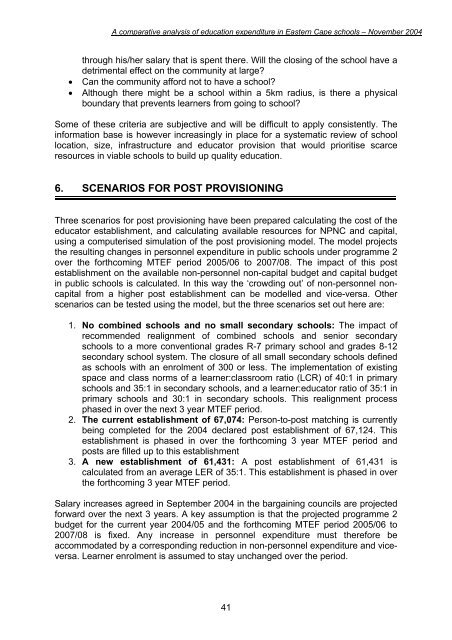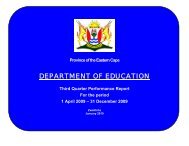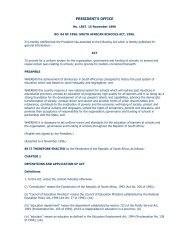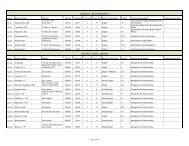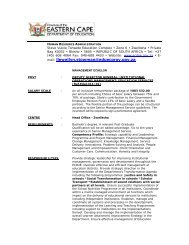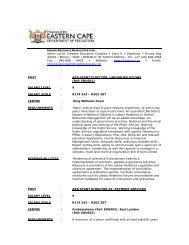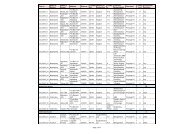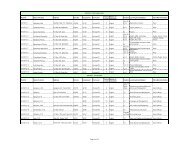School Community Integration Pilot Project - Department of Education
School Community Integration Pilot Project - Department of Education
School Community Integration Pilot Project - Department of Education
Create successful ePaper yourself
Turn your PDF publications into a flip-book with our unique Google optimized e-Paper software.
A comparative analysis <strong>of</strong> education expenditure in Eastern Cape schools – November 2004<br />
through his/her salary that is spent there. Will the closing <strong>of</strong> the school have a<br />
detrimental effect on the community at large?<br />
• Can the community afford not to have a school?<br />
• Although there might be a school within a 5km radius, is there a physical<br />
boundary that prevents learners from going to school?<br />
Some <strong>of</strong> these criteria are subjective and will be difficult to apply consistently. The<br />
information base is however increasingly in place for a systematic review <strong>of</strong> school<br />
location, size, infrastructure and educator provision that would prioritise scarce<br />
resources in viable schools to build up quality education.<br />
6. SCENARIOS FOR POST PROVISIONING<br />
Three scenarios for post provisioning have been prepared calculating the cost <strong>of</strong> the<br />
educator establishment, and calculating available resources for NPNC and capital,<br />
using a computerised simulation <strong>of</strong> the post provisioning model. The model projects<br />
the resulting changes in personnel expenditure in public schools under programme 2<br />
over the forthcoming MTEF period 2005/06 to 2007/08. The impact <strong>of</strong> this post<br />
establishment on the available non-personnel non-capital budget and capital budget<br />
in public schools is calculated. In this way the ‘crowding out’ <strong>of</strong> non-personnel noncapital<br />
from a higher post establishment can be modelled and vice-versa. Other<br />
scenarios can be tested using the model, but the three scenarios set out here are:<br />
1. No combined schools and no small secondary schools: The impact <strong>of</strong><br />
recommended realignment <strong>of</strong> combined schools and senior secondary<br />
schools to a more conventional grades R-7 primary school and grades 8-12<br />
secondary school system. The closure <strong>of</strong> all small secondary schools defined<br />
as schools with an enrolment <strong>of</strong> 300 or less. The implementation <strong>of</strong> existing<br />
space and class norms <strong>of</strong> a learner:classroom ratio (LCR) <strong>of</strong> 40:1 in primary<br />
schools and 35:1 in secondary schools, and a learner:educator ratio <strong>of</strong> 35:1 in<br />
primary schools and 30:1 in secondary schools. This realignment process<br />
phased in over the next 3 year MTEF period.<br />
2. The current establishment <strong>of</strong> 67,074: Person-to-post matching is currently<br />
being completed for the 2004 declared post establishment <strong>of</strong> 67,124. This<br />
establishment is phased in over the forthcoming 3 year MTEF period and<br />
posts are filled up to this establishment<br />
3. A new establishment <strong>of</strong> 61,431: A post establishment <strong>of</strong> 61,431 is<br />
calculated from an average LER <strong>of</strong> 35:1. This establishment is phased in over<br />
the forthcoming 3 year MTEF period.<br />
Salary increases agreed in September 2004 in the bargaining councils are projected<br />
forward over the next 3 years. A key assumption is that the projected programme 2<br />
budget for the current year 2004/05 and the forthcoming MTEF period 2005/06 to<br />
2007/08 is fixed. Any increase in personnel expenditure must therefore be<br />
accommodated by a corresponding reduction in non-personnel expenditure and viceversa.<br />
Learner enrolment is assumed to stay unchanged over the period.<br />
41


